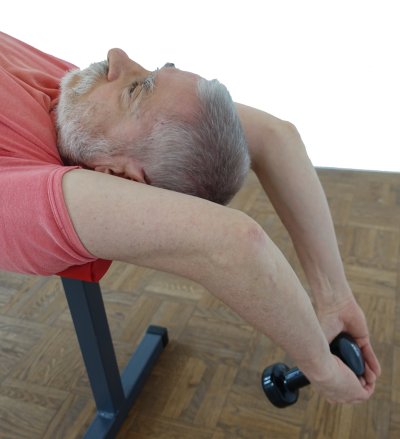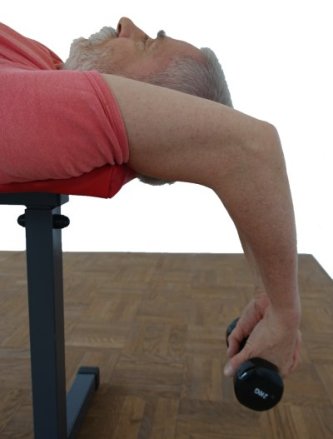yogabook / functional exercises / pull overs

 |  |
| normaler Griff | Untergriff |
Feedback: We would love to hear what you think about this description, give us feedback at:
postmeister@yogabook.org
last update: 18.5.2024
Level: A
- Classification
- Contraindication
- Effects
- Preparation
- Follow-up
- derived asanas
- similar asanas
- Diagnostics
- Instructions
- Details
- Variants
Contents
Classification
Functional exercise
Contraindication
Suffered shoulder dislocations are not a contraindication, but the arms must be carefully turned out so that there is no risk of a redislocation.
Effects
- (502) Strengthening of the Latissimus dorsi
- (512) Strengthening the pectoralis major
- (302) (307) Strengthening of the triceps, especially caput longum
- (501) Stretching the latissimus dorsi while holding the end position
Diagnostics
Instructions
- Lie on your back on a weight bench with your arms stretched almost all the way up and holding a dumbbell with your hands so that the top of your head rests in the palms of your interlocked hands.
- Slowly move the arms in further frontal abduction towards the floor until the limit of your stretching ability or strength is reached.
- Slowly bring your arms back to a vertical position. Repeat this two-part cyclic repetition.
Details
- The pull-ups are an excellent exercise to strengthen the adductors of the shoulder joint, in particular the pectoralis major, latissimus dorsi, triceps (caput longum), teres major and teres minor. If a maximum frontal abduction is held as the end position, this exercise is also good for stretching, especially the pectoralis major and even more so the latissimus dorsi. As only these two muscles are truncohumeral (the others are scapulohumeral), it is decisive for the stretching of these two whether the shoulder blades are elevated or rather depressed: a significantly greater stretching effect is possible in elevation. Of these five muscles, the triceps does not perform any significant rotation of the upper arm in the glenohumeral joint, the teres minor externally rotates the upper arm and the remaining three, pectoralis major, latissimus dorsi and teres major internally rotate it. They work slightly differently, for example the triceps adducts primarily from the front and secondarily from the side and can even perform retroversion (dorsal abduction) together with the latissimus dorsi.
- With its central head, caput longum, the triceps is biarticular, i.e. an adductor and retrovertor in the shoulder joint as well as an extensor of the elbow joint. It can therefore be strengthened very well in this exercise, all the more so when the elbow joint is actively extended, regardless of whether it is fully extended or not. It is not uncommon to experience muscle soreness in the caput longum after the first intensive pull-ups.
- The rotation of the arm is not only decisive for the effect of the posture. People with unstable shoulder joints in particular must not turn in their upper arms overhead postures, which requires them to be carefully turned out. Anyone who has already experienced a shoulder dislocation must carefully rotate the arms out continuously, as the turned in position greatly favours a new dislocation. It is also important to rotate the arms well when stretching, as the most powerful adductor muscles of the shoulder joint turn the upper arm inwards, as described above.
- Due to the truncohumeral course of the latissimus dorsi, you should try to keep the shoulder blades as elevated as possible.
- The elbows should be kept as close as possible so that the arms remain turned out wide.
- According to the design of the posture, there is no anatomical need to limit the extension of the elbow joints, as the elbows bend downwards against gravity (of the arm and the dumbbell), so that the cartilage coverings of the ulna (olecranon) and humerus bones in the elbow joint cannot be damaged, as could be the case the other way round with hyperextension. Depending on the weight, however, it will be very difficult to keep the arms largely extended.
- If you find it difficult or hard to keep your elbows tight, which is important for good effectiveness, you can practise the variation in which the dumbbells are initially gripped with an underhand grip. In the lower end position, the dumbbell then rests on the thumbs with the hands placed one on top of the other.
- Depending on the frontal abduction ability of the shoulder joint and the extension of the elbow joint, the dumbbell may touch the floor in the lower end position. If the exercise is used to stretch the latissimus dorsi and improve frontal abduction ability, this will significantly reduce its effectiveness. The arms should then be stretched as much as possible to prevent the dumbbell from touching the floor, or at least to make it touch the floor as lightly as possible.
- In the upper end position, do not move your arms all the way to the vertical, but keep the muscles performing the exercise under tension.
- If you feel a hollow back, pull your bent legs towards your chest.
elevated

Instructions
- Setze das Kopfende der Hantelbank auf eine hinreichende und stabile Erhöhung.
- Führe die Übung wie oben beschrieben dynamisch aus oder nimm die gehaltene Variante ein.
Details
- Bei guter Beweglichkeit in Richtung Frontalabduktion setzt die Hantel auf dem Boden auf, was vor allem in der gehaltene Variante eine deutliche Einbuße an Wirksamkeit darstellt, weil die dehnend wirkende Kraft dadurch massiv verringert werden kann. Die Erhöhung sollte daher so hoch gewählt werden, daß die Hantel nicht aufsetzen kann.
